Hopewell culture National Historic Park : Chillicothe, Ohio
Richard Thornton
Source : http://www.examiner.com/architecture-design-in-national/hopewell-culture-national-historic-park-chillicothe-ohio
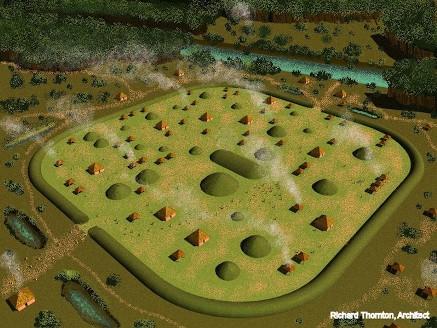
Mound City was not a city at all, but a 200+ acre ceremonial center near modern-day Chillicothe, Ohio
Photo: VR Image by Richard Thornton, Architect
...
The period in American Indian history that seems to epitomize this Golden Time had as one of its major players, what anthropologists label the Hopewell Culture. No one knows what the “Hopewell Peoples” called themselves. Anthropologists can only speculate as to which modern tribes trace their roots to this culture. What is known, though, is the vibrant cultural advancements they made, influenced other peoples hundreds of miles away. It is also known that the Hopewell’s either traveled long distances to obtain exotic materials for their art, or set up trade relationships that provided a steady flow of prestigious goods between regions of North America.
In the vicinity of the beautiful Scioto River Valley of Southeastern Ohio are situated the most spectacular vestiges of the Hopewell fluorescence. They are massive geometric earthworks that primarily functioned as ceremonial centers, which apparently drew visitors from long distances. Very few Hopewell houses have been found, and even fewer Hopewell villages. Their villages seem to have been transient settlements located on plateaus overlooking major streams. In fact the evidence of Hopewell settlements are so sparse, some anthropologists now speculate that the labor for constructing the earthworks came from several ethnic groups that traveled long distances to temporarily reside at the ceremonial centers during seasonal festivals and markets.
Who were the Hopewell People?
A new people moved into the Ohio Valley region around 200 BC. The Hopewell’s tended to be taller than the Adena people and also had differently shaped heads. Whereas communities with Adena-like characteristics appeared in not only Ohio, but the entire middle & upper Ohio River Valley, the tributary river valleys of the Ohio, and even the Chesapeake Bay region, large Hopewell sites are concentrated in central and Southern Ohio - particularly, the Scioto River Valley around Chillocothe, OH.
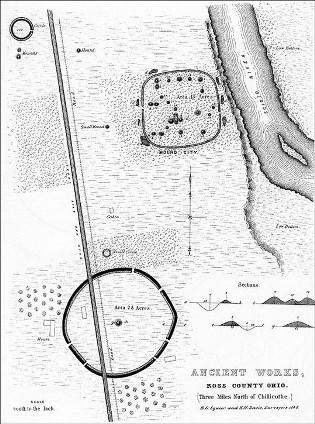
Although their daily lifestyle of hunting, gathering, and fishing were initially identical to that of the Adena, their architecture and community planning was different. The Hopewell houses were rectangular with vertical side walls formed by posts set in ditches. Their villages were transient and generally located on terraces overlooking river bottom lands. In fact, very few Hopewell village sites have even been excavated because their locations are unknown! Burial mounds and grounds were usually NOT located within villages, but in regional ceremonial centers. However, many ceremonial centers seem to have always had some permanent residents, who were perhaps priests, guardians or caretakers.
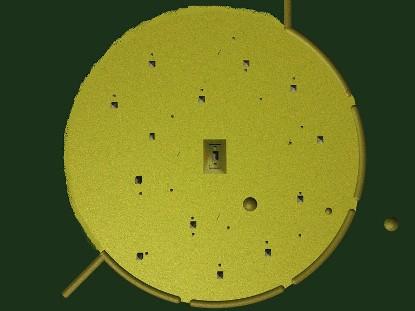
The Hopewell’s often practiced cremation and probably stored cadavers for mass reburial on special occasions. Eventually, the Hopewell’s also acquired knowledge of the cultivation of squash, beans and a primitive form of corn-perhaps from trade contacts with contemporary peoples in the Southeast. They never practiced agriculture on a large scale and seem to have always been primarily hunters and gatherers. However, nature was so bountiful in their region, that there was plenty of food to go around, at least until nears the end of the Hopewell’s construction activity.
The number and scale of primary Hopewell Ceremonial Centers are mindboggling. There were probably, well over a 100 primary Hopewell ceremonial centers in Ohio, Kentucky, West Virginia and Indiana. Some were Adena sites taken over by the Hopewell’s. Others were Hopewell from the beginning. Apparently, after a ceremonial center had been utilized for a certain period of time, it was abandoned and a new one begun nearby. Several Hopewell ceremonial centers cover over 200 acres and over 1000 feet in diameter: containing several million cubic feet of soil, rocks and detritus.
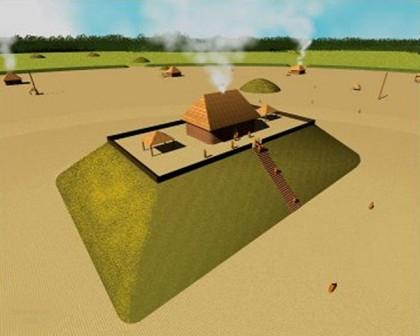
It is obvious that populations from many villages worked together for many generations to construct these public works projects. No architectural evidence has been found that there was hereditary elite, which forced the people to work on the sites. Either there was a very strong community value that all should work on the ceremonial sites, or perhaps, a religious belief that work on a ceremonial site guaranteed a good afterlife in the spiritual world.
The full ramifications of Hopewell religious beliefs and social values will probably never be known. The Hopewell obsession with death and the buzzard might be the reason that buzzards always return each spring to Hinkley, Ohio; in the heart of the former Hopewell territory.
Hopewell ceremonial sites took several different forms. The early ones were large rectangular or circular embankments, which enclosed (initially) rectangular structures or graves. In time the structures were abandoned and succeeding generations would pile dirt upon the “sacred site” - thus creating mounds while new structures were erected nearby. Some early centers also took the form of fortified plateaus. They may have actually been the first locations of Hopewell occupation when the Hopewell’s been a minority, but by 0 AD seem to have acquired ceremonial functions and some housing.
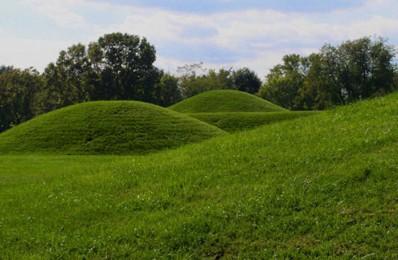
Middle and Late Hopewell ceremonial centers were often complex arrangements of precise geometric forms such as squares, circles, pentagons, hexagons, octagons, conical mounds, earthen causeways and linear embankments. Some of the last Hopewell ceremonial centers show influence from the architectural traditions of the Southeast. At such places as the Seip Mounds, a large truncated pyramidal mound dominated the site. This type of plan is a Southeastern tradition dating to at least 0 AD, and possibly influenced by the civilizations of Mexico. Anthropologists theorize that the temples on top of these Southeastern type mounds were utilized in the ritual “processing” of human cadavers, and therefore, are labeled “mortuary temples” or “charnel houses.”
There is no question that the Hopewell’s had an advanced understanding of geometry. The sophisticated interrelationship of various geometric shapes on many Hopewell sites is irrefutable. Right angles were created from squares which were created from circles and equilateral triangles. The more complex sites were possibly laid out using long cords that were cut or knotted to exact lengths to match sketches on bark paper.
There is also extensive evidence that the Hopewell’s used a standard unit of measurement throughout their domain. William Romain in his book, Mysteries of the Hopewell, identified at least one major Hopewell Ceremonial Center that was based on a standard length of 1,035 feet (315.47m.) Romain also identified a basic unit of measurement within individual buildings that equaled 2.106 feet (64.19cm.) This unit was apparently derived from the distance from the outstretched arm of an average Hopewell male (66.5”-168cm.)
Hopewell Culture National Historic Park
The best location to get an introduction to the Hopewell Culture is at the museum of the Hopewell Culture National Historical Park. The museum is located just outside of Chillicothe, Ohio adjacent to the Mound City and Hopewell Mounds Archaeological Zones. The word “Hopewell” is derived from a 19th century estate near the earthworks. The museum contains exhibits of some of the most famous Hopewell artifacts along with descriptions of the Hopewell ceremonial centers that are maintained by the National Park Service. From the Chillicothe museum location, one can take self-guided automobile tours of eight other satellite parks associated with the museum.
Several more spectacular Hopewell sites are maintained by the Ohio Historical Society, State of Ohio or local governments. When visiting the Seip Mounds and Fort Center sites, make a point of visiting historic Amish communities in their vicinity. Between April and October Amish ladies sell their famous delicacies, baked goods and crafts from their front yards!
The Ohio Historical Society maintains this web site to educate visitors on its Native American heritage and accessible Native American earthworks:
http://ohsweb.ohiohistory.org/gallery2/main.php?g2_itemId=279